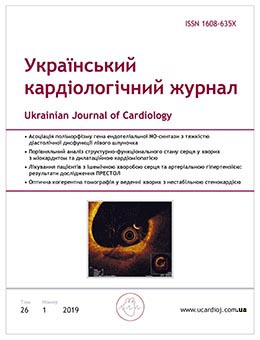Optical coherent tomography in patients with unstable angina
Main Article Content
Abstract
The article describes modern approaches to the study of atherosclerotic plaques characteristics using invasive imaging methods of the coronary arteries. We briefly highlighted the features of the so-called «vulnerable» atheroma. The features of the method of optical coherent tomography (OCT) in determining the thickness of the fibrous cap of a vulnerable plaque are considered. Factors limiting the possibilities of OCT and advantages over intravascular ultrasound before and after stenting are described. The clinical case is presented as a complex and uncertain one for the further tactics of treating a patient with non-Q myocardial infarction and a destroyed plaque in the LAD. The objective of this clinical case was to show the advantages of OCT as an additional method for assessing the structure of the vascular wall at the site of the destroyed plaque, the extent of the affected area, to assess the adequacy of stent implantation and the degree of pressure of stent branches, the possible dissection with an angio-graphically adequate result, which made it possible to identify malposition earlier. Also, the OCT method can be used in the remote period to visualize the degree of stent endothelization and determine the duration of double antiplatelet therapy in patients after stenting with drug-eluting stents.
Article Details
Keywords:
References
Huang D, Swanson EA, Lin CP, Schuman JS, Stinson WG, Chang W, Hee MR, Flotte T, Gregory K, Puliafito CA. Optical coherence tomography. Science. 1991 Nov 22;254(5035):1178–81.
Puliafito CA, Hee MR, Lin CP, Reichel E, Schuman JS, Duker JS, Izatt JA, Swanson EA, Fujimoto JG. Imaging of Macular Diseases with Optical Coherence Tomography. Ophthalmology. 1995 Feb;102(2):217–29.
Chen Y, Aguirre AD, Hsiung PL, Desai S, Herz PR, Pedrosa M, Huang Q, Figueiredo M, Huang SW, Koski A, Schmitt JM, Fujimoto JG, Mashimo H. Ultrahigh resolution optical coherence tomography of Barrett’s esophagus: preliminary descriptive clinical study correlating images with histology. Endoscopy. 2007 Jul;39(7):599–605.
Babalola O, Mamalis A, Lev-Tov H, Jagdeo J. Optical coherence tomography (OCT) of collagen in normal skin and skin fibrosis. Arch. Dermatol. Res. 2014;306(1):1–9.
Korde VR, Bonnema GT, Xu W, Krishnamurthy C, Ranger-Moore J, Saboda K, Slayton LD, Salasche SJ, Warneke JA, Alberts DS, Barton JK. Using optical coherence tomography to evaluate skin sun damage and precancer. Lasers Surg. Med. 2007;9(39):687–695.
Schmitz L, Reinhold U, Bierhoff E, Dirschka T. Optical coherence tomography: its role in daily dermatological practice. J. Dtsch. Dermatol. Ges: JDDG. 2013;6(11):499–507.
Tsai T-H, Jee S-H, Dong C-Y, Lin S-J. Multiphoton microscopy in dermatological imaging . J. Dermatol. Sci. 2009;56(1):1–8.
Vakoc BJ, Fukumura D, Jain RK, Bouma BE. Cancer imaging by optical coherence tomography: preclinical progress and clinical potential. Nat. Rev. Cancer. 2012;5(12):363–368.
Freitas AZ, Zezell DM, Vieira NDJr. Imaging carious human dental tissue with optical coherence tomography. J. Applied Phys. 2006;2(99).
Drexler W. Ultrahigh-resolution optical coherence tomography. J. Biomed. Optics. 2004;1(9):47–74.
Fercher AF. Optical coherence tomography – development, principles, applications. Zeitschrift für Medizinische Physik. 2010;4(20):251–276.
Raffel OC, Akasaka T, Jang I-K. Cardiac optical coherence tomography. Heart Br. Card. Soc. 2008;9(94):1200–1210.
Mintz GS, Nissen SE, Anderson WD, Bailey SR, Erbel R, Fitzgerald PJ, Pinto FJ, Rosenfield K, Siegel RJ, Tuzcu EM, Yock PG. American College of Cardiology clinical Expert Consensus Document on standards for acquisition, measurement and reporting of intravascular ultrasound studies (IVUS). Eur. J. Echocardiogr. 2001;4(2):299–313.
Moharram MA, Yeoh T, Lowe HC. Swings and roundabouts: Intravascular Optical Coherence Tomography (OCT) in the evaluation of the left main stem coronary artery. Int. J. Cardiol. 2011;2(148):243–244.
Brezinski ME, Tearney GJ, Bouma BE, Izatt JA, Hee MR, Swanson EA, Southern JF, Fujimoto JG. Optical coherence tomography for optical biopsy. Properties and demonstration of vascular pathology. Circulation. 1996;6(93):1206–1213.
Burke AP, Farb A, Malcom GT, Liang YH, Smialek J, Virmani R. Coronary risk factors and plaque morphology in men with coronary disease who died suddenly. New Engl. J. Med. 1997;18(336):1276–1282.
Kume T., Akasaka T., Kawamoto T. et al. Measurement of the thickness of the fibrous cap by optical coherence tomography. Am. Heart J. 2006, 4 (152), 755.e1–755.e4.
Kume T, Akasaka T, Kawamoto T, Ogasawara Y, Watanabe N, Toyota E, Neishi Y, Sukmawan R, Sadahira Y, Yoshida K. Assessment of coronary arterial thrombus by optical coherence tomography. Am. J. Cardiol. 2006;12(97):1713–1717.
Meng L, Lv B, Zhang S, Yv B. In vivo optical coherence tomography of experimental thrombosis in a rabbit carotid model. Heart (Br. Cardiac Soc.). 2008;6(94):777–780.
Brezinski ME. Optical coherence tomography for identifying unstable coronary plaque. Int. J. Cardiol. 2006;107(2):154–165.
Bezerra HG, Costa MA, Guagliumi G, Rollins AM, Simon DI. Intracoronary Optical Coherence Tomography: A Comprehensive Review. Clinical and Research Applications. JACC: Cardiovasc. Interv. 2009;2(11):1035–1046.

